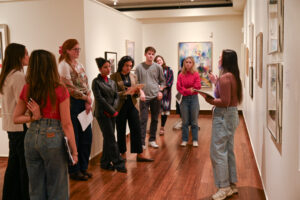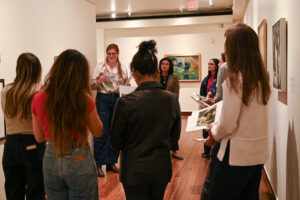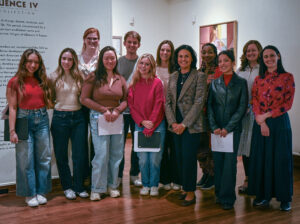A picture is worth a thousand words: Advanced writing seminar offers students hands-on art historian experience
 On a crisp fall evening in North Nashville, the sound of clapping emanates from Fisk University’s Carl Van Vechten Art Gallery. Inside, Vanderbilt students walk the large room, surrounded by a rich array of 20th century early modernist works from the collection of Alfred Stieglitz.
On a crisp fall evening in North Nashville, the sound of clapping emanates from Fisk University’s Carl Van Vechten Art Gallery. Inside, Vanderbilt students walk the large room, surrounded by a rich array of 20th century early modernist works from the collection of Alfred Stieglitz.
As they tour the space, each student gives a 15-minute presentation highlighting pieces from the collection that they’ve studied, as part of Associate Professor of History of Art and Architecture Rebecca VanDiver’s course, HART 3810W Exhibiting Historical Art.
Offered as an Immersion experience, VanDiver’s advanced writing seminar gives students an opportunity to explore the past, present, and future of art through hands-on experiences. Over the course of the semester, students conducted round-table class discussions, participated in research and writing workshops, listened to guest speakers, and visited the Stieglitz Collection at Fisk.
“There is no comparison that taking an art history course that offers access to the physical artworks trumps viewing them projected in a lecture hall,” VanDiver said. “Studying the Stieglitz Collection from multiple angles—its significance within narratives of U.S. Modernism, its acquisition by and display in a Historically Black College and University, and its current co-ownership—gave students an unreplicated experience to engage in object-based learning while developing a nuanced understanding of the interplay between art, history, and museum practices.”
VanDiver said she chose the Stieglitz Collection as the focus for her fall 2024 seminar because 2024 marked the 75th anniversary of Fisk acquiring the collection. In November 1949, American modernist painter Georgia O’Keeffe donated 101 artworks from the estate of her late husband, Alfred Stieglitz, to the university. Today, Fisk co-owns the collection with Crystal Bridges Museum of Art in Bentonville, Arkansas, and the collection moves between the institutions every two years.
“With the anniversary of the bequest and the return of the collection to Fisk in the summer, I jumped at the opportunity to bring students behind the scenes and to facilitate research projects that would be useful to Fisk and Crystal Bridges,” VanDiver said. “I designed the course to include projects that mimicked the type of research I conduct as a professional art historian. Students visited the gallery, spent time working with archival materials at Fisk University’s Special Collections, met with curators and conservators, and then translated their findings into public gallery talks, timeline entries, and interpretive object labels.”
Katherine Dodge, a senior majoring in art history and human and organizational development, chose her major after taking a few art history classes at Vanderbilt. For her, working with the Stieglitz Collection was an engaging and fulfilling experience.
“Vanderbilt’s proximity to the collection, both in regard to location and Professor VanDiver’s work with the collection, made this experience more involved and unique,” Dodge said. “Through another university, I would not have been able to work as closely with the art and gain such a deep understanding of the material.”
Owen Smith, a senior majoring in economics, history of art, and medicine, health, and society, said he learned not only about the collection and American Modernism, but also about the broader world of art through VanDiver’s course.
“This class was very much an experience,” Smith said. “Not only were we working on assignments for our grade, but we were producing real materials for use by Crystal Bridges and Fisk University. This was also one of the first classes I have taken where I am the first scholar doing the research. There was a sense of responsibility, pride, and even prestige that I think we all felt this semester, which is something so unique for a class.”
Smith intends to work in health care consulting after graduating; however, after taking the writing seminar, he said he plans to find ways to integrate art into his life going forward.
“I don’t know where I’ll go after this next stage and the larger trajectory of my career,” he said, “but after this class I know that it will be a goal of mine to incorporate elements of this class and what I’ve learned studying the history of art into it.”
